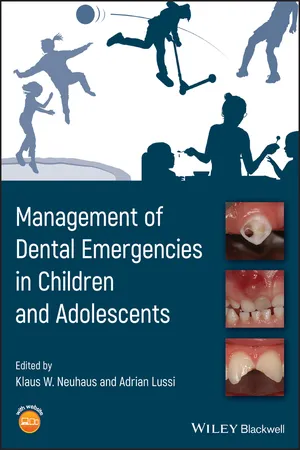
Management of Dental Emergencies in Children and Adolescents
- English
- ePUB (mobile friendly)
- Available on iOS & Android
Management of Dental Emergencies in Children and Adolescents
About This Book
A unique, multidisciplinary manual for the treatment of pediatric dental emergencies for general practitioners and non-pediatric specialists
Management of Dental Emergencies in Children and Adolescents presents the diagnostic skills, treatment options, and management strategies necessary to provide effective and appropriate dental care for children and adolescents.
This authoritative manual helps dental practitioners manage potentially stressful situations with children and adolescents while improving their competence in a wide range of urgent pediatric situations. An emphasis on managing the therapeutic demands of both younger patients and their parents enables readers to have greater confidence in handling demanding emergency situations in daily practice. An expert team of contributors explain how to manage tooth substance loss, endodontic problems in deciduous teeth, the long?term consequences of early tooth loss, the dental issues related to oral health, and more.
Guiding practitioners through the unique challenges of pediatric dental emergencies, this book:
- Explains the differences in treating and managing dental emergencies in children compared to adults
- Covers all types of pediatric dental emergencies including open pulp in permanent and deciduous teeth, missing teeth, and non-infective dental conditions
- Offers clinical vignettes and photographs to highlight clinical relevance
- Includes chapters by experts in multiple disciplines such as endodontics, restorative dentistry, pediatric dentistry, prosthodontics, and orthodontics
The first textbook to focus exclusively on young patients in need of acute dental care, Management of Dental Emergencies in Children and Adolescents is a much-needed resource for general and specialist dentists as well as trainee and specialist pediatric dentists.
Frequently asked questions
Information
Unit 1
General Considerations for Emergency Management in Children and Adolescents
1.1
Developmental and Histological Aspects of Deciduous and Young Permanent Teeth
Differences between Deciduous and Permanent Teeth


Tooth Development and Structural Characteristics of Dental Hard Tissue
Table of contents
- Cover
- Table of Contents
- Contributors
- Preface
- Invited Preface
- Acknowledgements
- About the Companion Website
- Unit 1: General Considerations for Emergency Management in Children and Adolescents
- Unit 2: Management of Tooth Substance Loss
- Unit 3: Management of Open Pulp in Permanent Teeth
- Unit 4: Management of Open Pulp in Deciduous Teeth
- Unit 5: Management of Missing Teeth
- Unit 6: Management of Oral Health Conditions
- Unit 7: Management of Non‐infective Dental Conditions
- Index
- End User License Agreement